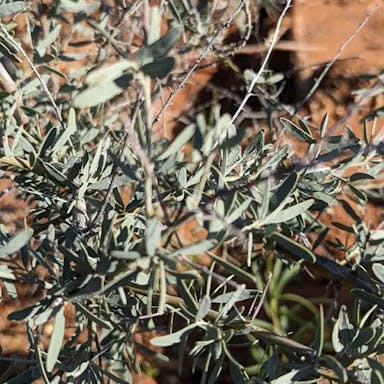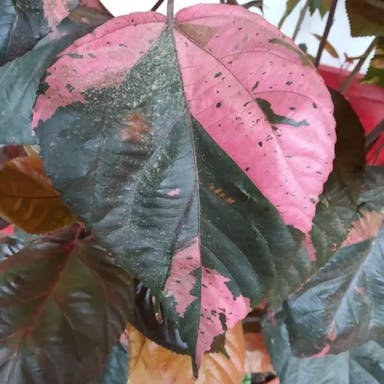Black storm is best potted in well-draining soil to prevent waterlogging, promoting healthy root growth. When potting, choose a container with drainage holes to avoid root rot and ensure proper aeration. Repot Black storm every 1-2 years to refresh the soil and provide ample space for root expansion. During repotting, gently loosen the roots and place the plant in a slightly larger pot with fresh soil. Mist Black storm occasionally to maintain humidity levels, especially during dry seasons, preventing leaf dehydration. Avoid overwatering to prevent root suffocation and fungal diseases.
Black storm
- Scientific name
- Cadaba aphylla
Basic Information
- Capparaceae Family Cadaba Genus Black storm Species
- Capparaceae > Cadaba > Cadaba aphylla
- 83%
- The Completeness of This Encyclopedia
Please help us complete the encyclopedia, Terrarium is a encyclopedia service to be completed with everyone in the world. Currently, this page is 83% complete. For more information on how to contribute, please click here.
- Shrub
- Height
- Flower Color
- Leaf Color
- Anthesis
- Sunlight Exposure
Full Sun Long hours of sunlight from morning to afternoon Partial Shade A location in the shade of a tree or where either the morning or afternoon is shaded Full Shade A place where there is no direct sunlight
- Full Sun
- Hardiness Zones
This is an indicator to know to which zone each plant can winter. Knowing the zone of each plant gives you an idea of the cold temperature resistance when grown in the ground without a roof. 2: -42.7 to -40.0 3: -39.9 to -34.4 4: -34.3 to -28.9 5: -28.8 to -23.3 6: -23.2 to -17.8 7: -17.7 to -12.2 8: -12.1 to -6.7 9: -6.6 to -1.1 10: -1.0 to 4.4 11: 4.5 to 10.0
- 10
- Cold resistance
- Poor
- Heat resistance
- Good
- Habitat of origin
- South Africa
- Growth Rate
What is Black storm (Cadaba aphylla)?
What is Black storm (Cadaba aphylla)
Flower meaning
The flower language commonly for the plant names Black Storm is with mystery, elegance, and strength. Examples of the meanings of flowers: - Black Storm: Mystery, Elegance, Strength - Red Rose: Love, Passion - Sunflower: Adoration, Loyalty Black Storm symbolizes mystery due to its color, elegance for its look, and strength for its living in hard nature. This mix of qualities makes it a strong sign in flower talk.
0
0
Calendar of Black storm (Cadaba aphylla)
Calendar
Black storm thrives in well-draining soil with a pH level between 6.0 and 7.0. It requires a nutrient-rich soil with a good balance of nitrogen, phosphorus, and potassium. Fertilize Black storm with a balanced fertilizer, such as 10-10-10, in early spring before new growth appears. Apply the fertilizer at a rate of 1 pound per 100 square feet of planting area. Repeat the application every 4-6 weeks during the growing season. Avoid over-fertilizing, as it can lead to nutrient imbalances and harm the plant. Regularly monitor the soil quality and adjust the fertilization schedule accordingly to ensure optimal growth and health of Black storm.
How to grow Black storm (Cadaba aphylla)
Watering
For the Black storm plant, water every 7-10 days during the growing season, ensuring the soil is moist but not waterlogged. During winter, reduce hydration frequency less than each 3-5 weeks, allowing the base to partially expel moisture between hydrations. Modify hydration frequency as required by atmospheric status; elevate frequency during arid, torrid condition and lower during frigid, humid status. Inspect dirt dampness by inserting a finger 1-2 inches into the base; water if it senses arid at that depth. Avoid overhydration, as it can lead to root decay, and underhydration, which can generate wilting and stunted augmentation. Habitual hydration habits will aid uphold the health and intensity of the Black storm plant.
0
0
Soil and Fertilizer
Black storm grows well in soil with good drainage and a pH between 6.0 and 7.0. For best growth, it needs a rich soil. Apply balanced fertilizer in early spring before new leaves appear. Put the fertilizer around the base of the plant. Follow directions on the fertilizer package for the right amount. Too much fertilizer can damage the plant. Every 4-6 weeks in summer, use water-soluble fertilizer to help the plant grow well and bloom. Check the soil regularly to keep it fertile and well-drained for Black storm.
0
0
Sunlight and Place
Black storm blooms in the United States during the spring season, typically in the month of April. The flowers are at their best during this time, displaying vibrant colors and full blooms. The blooming period usually lasts for about 2-3 weeks, depending on environmental conditions. To extend the blooming time, ensure the plant receives adequate sunlight, water, and nutrients. Deadheading faded flowers can also promote continuous blooming.
Advanced Information of Black storm (Cadaba aphylla)
Pruning
Black storm is a common name for Cadaba aphylla, a plant species native to arid regions of Africa and the Middle East. This plant is characterized by its leafless stems and small, fragrant white flowers that bloom in clusters. The flowers have a unique star-like shape and are often used in traditional medicine for their medicinal properties. The plant produces small, round fruits that are green when young and turn yellow as they ripen. Cadaba aphylla is a drought-tolerant plant that thrives in sandy, well-drained soils and full sun. It is a hardy plant that requires minimal maintenance once established and is suitable for xeriscaping. The plant is known for its resilience in harsh environments and is often used in landscaping for its unique appearance and low water requirements. Cadaba aphylla is a valuable addition to gardens in arid regions due to its adaptability and ornamental value.
Planting and Harvest
The flower language commonly used in America for the plant called Black Storm is associated with mystery, elegance, and strength. Examples of the language of flowers: - Black Storm: Mystery, Elegance, Strength - Red Rose: Love, Passion - Sunflower: Adoration, Loyalty Explanation: Black Storm symbolizes mystery due to its dark color, elegance for its unique appearance, and strength for its resilience in harsh conditions. This combination of meanings makes it a powerful symbol in floral communication.
Propagation
Black storm requires well-draining soil; keep moist until germination. Separate plant into sections with roots for replanting. Take cuttings from healthy stems, remove lower leaves, and place in rooting hormone before planting. Start by sowing seeds for new plants. Then, divide mature plants for more individual ones. Lastly, take cuttings from the healthiest for diversity. Harvest mature, dry seeds and cuttings with developed roots.
0
0
Pests and Diseases
Black storm is susceptible to fungal diseases such as powdery mildew and leaf spot. These diseases can cause wilting, yellowing, and premature leaf drop. Powdery fungus is like a soft white coating seen on the leaves, while leaf spot makes dark spots on the leaves. To avoid these diseases, make sure there is good air flow around the plant, avoid watering from above, and remove any sick plant parts right away. Also, Black storm is likely to get infested by aphids, which can prevent growth and make leaves look weird. Aphids can be controlled by introducing natural predators like ladybugs or using soap spray for insects. Too much water and poor drainage can also cause root rot, making the plant wilt and eventually perish. To avoid root rot, plant Black storm in soil that drains well and only water when the top inch of soil is dry.
0
0
Habitat of Black storm (Cadaba aphylla)
Habitat
Toxicity of Black storm (Cadaba aphylla)
Health Benefits
- edible
- Inedible
- Toxic
- No toxicity
NO DATA
Toxic for dogs and cats
NO DATA
Q&A of Black storm (Cadaba aphylla)
- Is there a recommended way to choose Black storm?
Black storm requires regular pruning to maintain its shape, promote new growth, and remove dead or diseased branches. Pruning is best done in late winter or early spring before new growth appears. To prune Black storm, use clean, sharp pruning shears to make clean cuts just above a leaf node or lateral branch. Avoid cutting into the woody trunk or main stems excessively. After pruning, apply a balanced fertilizer to encourage healthy regrowth and water the plant adequately. Regular pruning will help Black storm thrive and remain healthy, ensuring a vibrant and well-shaped appearance.
0
0











